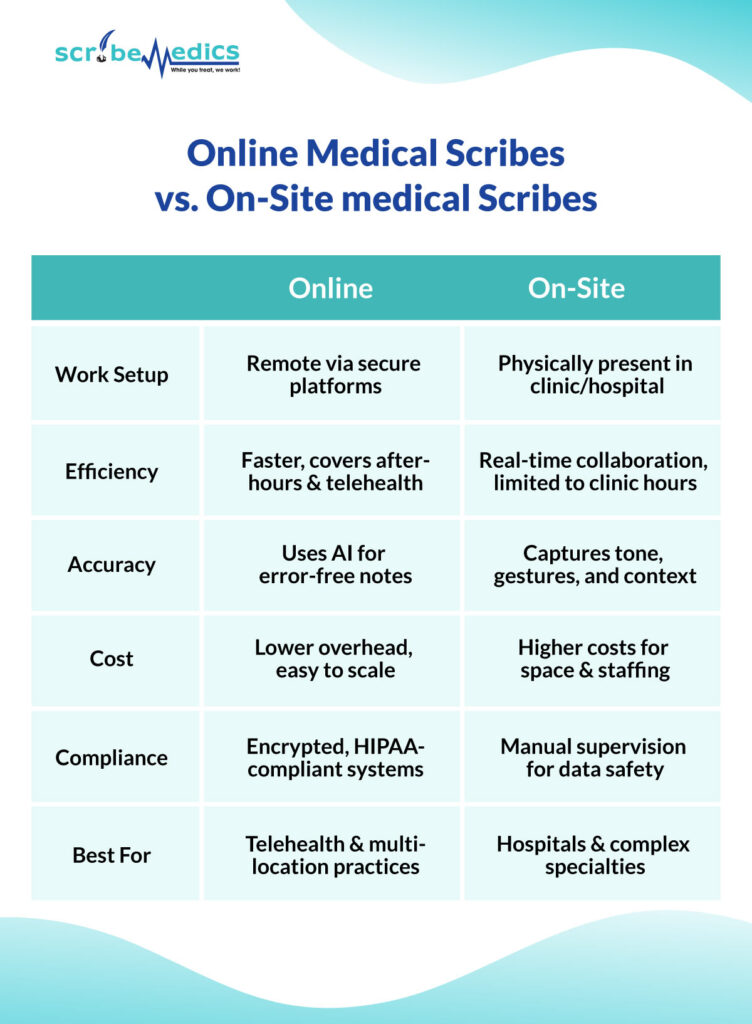In modern healthcare, documentation takes up a considerable amount of time from the doctor’s daily routine. Most physicians throughout the USA now spend more time with administrative tasks than with patients. In order to counter this, healthcare providers are turning to medical scribe services; these work as professionals who manage documenting patient encounters and ensure accurate documentation within electronic health records (EHRs).
But as technology is evolving, the traditional way of documenting patient encounters has also changed. And since the rise of digital health, a new question has risen in medical practices should I hire online medical scribes or on-site medical scribes? The debate between online medical scribes vs. on-site medical scribes is now the centre of how hospitals, clinics, and private practices in the USA are dealing with their operation.
Traditionally, medical scribes worked beside physicians during patient visits, entering details into EHRs. However, digital transformation and telemedicine have given rise to virtual medical scribes and remote medical scribes who work from anywhere, offering flexibility and scalability.
On-site medical scribe services and virtual scribe services are both meant to relieve the pressure of the workload and let the clinicians concentrate on the patients. Each model, however, presents advantages, disadvantages, and applications in different scenarios. This blog compares the two, addresses how they influence patient care, and helps determine which scribing method will fit best into a healthcare organization.
What Are Online Medical Scribes (Virtual/Remote)?
Online medical scribes also known as virtual medical scribes or remote medical scribes, are professionals who conduct medical documentation for healthcare providers from remote location. Instead of being physically present at the patient’s visit, they use secure digital platforms to connect and capture/record the patient interaction in real time. These professionals enter the information directly into electronic health records (EHRs), which leads to faster documentation and less work for the doctors.
This arrangement enables the doctors to concentrate on the patients during the consultation while the virtual scribe performs all the tasks and documentation duties like taking notes which are time-consuming and can cut down on the clinical time and patient consultation.
How Virtual Medical Scribing Works
The virtual medical scribing is done through secure channels like audio streaming, live video calls, or dedicated virtual scribe platforms. The online medical scribe either listens or watches the consultation and then documents the important medical information symptoms, diagnosis, treatments, and follow-up directions.
Most of the virtual scribe services are integrated with current hospital software to facilitate the workflow. As the physician interacts with the patient, the remote scribe transcribes the encounter and organizes the data within the EHR. This means every patient encounter is accurately recorded without interrupting the provider’s flow.
Tools and Technology Used
Most remote medical scribes rely on advanced software powered by AI virtual scribes and intelligent virtual scribing platforms. These can be auto-generated clinical summaries, categorized and ordered SOAP notes, even diagnostic or billing code recommendations based on the conversation. This automation streamlines manual charting, and frees up doctors to spend less time on paperwork and more on patient care.
Many virtual medical scribing solutions also come with features like voice recognition, real-time transcription, and smart editing tools. These ensure that every word spoken during patient visits is captured accurately. Some even use predictive algorithms to identify missing details or flag incomplete notes, helping providers maintain consistent medical documentation standards.
Security continues to be a key concern. Virtual medical scribe services that are offered in the United States utilize a HIPAA-compliant cloud infrastructure, end-to-end encryption, and access controls to keep the information about patients safe. Patient data is protected through a series of security measures, and only those with proper authorization can access it. The virtual scribe platforms are allowing healthcare practices to change in documentation as the technology gets more and more sophisticated, faster, and deeply integrated into clinical workflows.
Training and Expertise
Just like traditional scribes, online medical scribes go through dedicated training programs to understand medical terminology, clinical workflows, and the proper use of electronic health records (EHRs). This training ensures that they can handle diverse specialties whether it’s cardiology, dermatology, orthopedics, or internal medicine, with precision and confidence.
Since virtual medical scribes usually work in different time zones and healthcare settings, flexibility is a core skill. The understanding of each provider’s preferences and the ability to adjust one’s voice according to the physician’s communication style lead to trust and allow both doctors and patients to have a convenient experience.
Benefits of Online Medical Scribing
Online scribing frees up doctors’ time, enhances quality of life and increases patient satisfaction.
Clinics save on infrastructure costs since virtual scribes work remotely. Moreover, virtual scribe services provide flexibility for expanding teams without physical space constraints. In short, virtual medical scribes have become the backbone of digital healthcare documentation combining accuracy, speed, and convenience to help doctors across the United States of America deliver better care.
What Are On-Site Medical Scribes?
An on-site medical scribe, commonly referred to as a sitting scribe or traditional scribe, is a professional who physically accompanies the healthcare providers in clinics, hospitals, or private practices. These professionals listen to and document patient encounters in real time as consultations happen.
On-site medical scribe services have been a core element of clinical workflows for a long time,
Their physical presence allows them to observe patient interactions closely capturing facial expressions, tone of voice, and nonverbal cues that might not translate through a screen.This direct observation adds invaluable context to the medical documentation process, assisting in the effort to accurately record each and every patient story.
In contrast to remote medical scribes, on-site scribes are a part of the clinical surroundings. They frequently cultivate close bonds with the doctors, nurses, and other personnel, and thus, they become the trusted parts of the care team.
How On-Site Scribing Works
During each patient visit, the on-site scribe jots down any pertinent details of that visit like symptoms, medical history, diagnosis and results of tests performed, as well as plans for treatment. While standing or sitting alongside the doctor in that exam room. As the conversation unfolds, the details are entered directly into electronic health records (EHRs).
Because they share the same space, communication between the physician and scribe happens instantly. If something is unclear, the doctor can clarify it right away, ensuring timely documentation and accurate notes. This immediate collaboration makes on-site medical scribe services especially useful in fast-paced environments like emergency departments, surgical centers, and specialty clinics.
Their presence also helps maintain the flow of consultations. The physician doesn’t need to pause to type notes, allowing them to stay fully focused on patients and spend more time on meaningful interactions.
Key Responsibilities
The role of an on-site medical scribe goes beyond just typing notes. They are responsible for ensuring that every detail from the patient encounter is properly captured before the patient leaves the room. This includes documenting medical histories, recording physician assessments, and updating orders for labs or imaging.
The scribe’s tasks might also extend to the administrative side wherein they would help with patient record retrieval, test result cataloging, or billing-related data input. In certain hospitals, the scribe situated on the premises also helps facilitate the communication between the doctor and other departments thus contributing to an uninterrupted workflow during the day.
The main objective of the scribes is to keep the records accurate and the patient records updated. By taking care of the major part of the documentation, they are able to set doctors free for more patient care thus making the process more efficient and bringing about satisfaction for both parties.
Skills and Training
On-site medical scribes undergo rigorous training programs to prepare for real-world healthcare environments. They learn medical terminology, anatomy, and EHR navigation. They are also trained in compliance protocols such as HIPAA and patient privacy regulations.
In the United States of America (USA), hospitals in large numbers bring on-site scribes from backgrounds such as pre-med, nursing, or allied health sciences. Their educational basis along with the experience from live patient care that they have, makes them fit for the role and able to take it on.
Additionally, working in person exposes on-site scribes to medical procedures, teamwork dynamics, and real patient emotions. This experience improves their clinical awareness and empathy qualities that enrich their contribution to the healthcare team.
Advantages of On-Site Medical Scribes
Among many other advantages one of the most important and remarkable is the on-site medical scribe service’s ability to see and comprehend the whole picture. They are able to observe and take into account the physical state, body language, and feelings of the patient and all these factors can affect diagnosis and treatment.
The doctor and scribe are communicating at the same time, hence the instant corrections or updates to documentation. This lowers the likelihood of missing key details and contributes to better electronic health records (EHRs) accuracy.
This immediate availability is very important in high-risk health care environments, such as emergency rooms or trauma centers.Every second counts, and having an on-site scribe ensures that crucial information is captured as events unfold. It also enhances teamwork, as the scribe becomes part of the care rhythm anticipating needs, organizing data, and ensuring smooth transitions between patients.
Comparing Online Medical Scribes vs. On-Site medical Scribes
One of the critical choices which a healthcare provider could make nowadays is choosing between online medical scribes vs. on-site medical scribes. The two models target reducing the escalating administrative burden, enhancing medical documentation, and allowing doctors to concentrate on patients. Yet, they differ in how they integrate into daily workflows, their technology, and the flexibility they offer.
For example, an on-site medical scribe might do well in a busy hospital setting where quick communication is a must, while an online or remote medical scribe may efficiently manage telehealth documentation of several clinics at once. These differences grasping the ones that best fit a practice’s size, structure, and patient volume help physicians in making their decision.
Below is a detailed comparison of online medical scribes vs. on-site medical scribes based on workflow, accuracy, cost, compliance, flexibility, and technology.

Efficiency and Workflow
The choice between online medical scribes vs. on-site scribes heavily relies on the particulars of the healthcare environment and thus, efficiency is more or less the same. Virtual scribes are most suitable in settings that are completely digital and consist of multiple locations where speed and remote access are the main factors. They can participate in consultations over the internet, make notes at the same time as the talk and even revise electronic health records (EHRs) without the provider being disturbed.
In addition, remote medical scribes can cover after-hours, thus ensuring that documentation is done on time even if the doctors are away from the clinic. This not only minimizes backlogs but also raises the quality of life at work. However, on-site scribes are better when it comes to immediate and direct collaboration. They will be able to give you the details of the patient’s case, although with limitations of the clinic’s working hours.
Accuracy and Quality
Both scribing models prioritize accurate documentation, but their accuracy depends on how they capture and process data. On-site scribes hear and observe everything firsthand, allowing them to record nonverbal cues or clarify details instantly.
On the other hand, online medical scribes rely on AI-powered virtual scribe tools and automated transcription technology for higher speed and lower human error. These systems not only recognize medical terminology but also structure speech in notes and make suggestions for corrections. In most cases, virtual medical scribing services also incorporate a layer of human review, thus, ensuring that all clinical data is re-checked before it goes to the physician.
Cost and Scalability
The major factor that differentiates online medical scribes and on-site medical scribes is cost. The services of on-site medical scribes are charging higher prices since they require office space, training, HR management, and hardware installation in addition to the salaries of the scribes. Moreover, they are also limited by the area practices can only select scribes from that particular region.
On the other hand, virtual scribe services are economical and very flexible in terms of scaling up and down. A single company providing remote scribes can take care of several doctors in different states while still providing coverage for different time zones. For the clinics located in the United States, this means that they can quickly grow without the need to hire more in-house staff or investing in infrastructure.
Compliance and Security
In the healthcare sector, compliance and patient privacy are always put to the top of the list of priorities. Both online medical scribes and on-site scribes have to comply with HIPAA regulations, but each of them has a different method of handling security.
Virtual medical scribe companies protect sensitive information through encrypted platforms, access controls, and cloud-based virtual scribe platforms. A large number of virtual medical scribe services operating in the USA deploy enterprise-grade cybersecurity systems with routine audits.
As opposed to that, scribes working on-site are part of the clinic’s network and abide by the compliance procedures established by the clinic. While they are less dependent on digital systems, they still need to be monitored to prevent physical or procedural security breaches.
Technology Integration
Technology is where online medical scribes vs. on-site medical scribes differ most. Virtual medical scribing solutions use tools like NLP-based transcription, AI automation, and real-time speech recognition to improve documentation speed and accuracy. These systems are constantly learning, adapting to physician preferences, and minimizing manual effort.
On-site scribes, meanwhile, rely on direct observation and manual data entry. While this allows them to capture subtle patient cues, it can be slower and less scalable. As the healthcare industry becomes more digital, virtual medical scribes are better equipped to integrate with EHR systems, telehealth platforms, and future-ready AI tools that support faster, error-free documentation.
Benefits of Online Medical Scribes vs. On-Site medical Scribes
Online medical scribes and on-site medical scribes both have a positive influence on the efficiency, accuracy, and physician satisfaction. Nonetheless, there are some differences in strengths of each model based on the clinic’s configuration, patient flow, and care environment. The following sections will discuss the major advantages of both modalities.
Benefits of Online (Virtual/Remote) Medical Scribes
Lower Costs
Healthcare practices are financially benefiting because they are not required to pay for physical space in the office, updating the computer equipment, or hiring the in-person staff. Virtual medical scribe services across the United States are working remotely and thus, cutting down overhead and administrative costs for clinics.
Scalability
When there is a rise in patient loads, remote scribe services can effortlessly add more scribes without going through new hiring or setting up delays. This capacity allows healthcare providers to quickly and smoothly expand their operations.
Flexibility
Virtual medical scribe services give support through all shifts and across all time zones. A remote medical scribe can document patient encounters in real time meeting the provider’s schedule whether it is day or night without disturbing the workflow.
Improved Patient Focus
Physicians will be able to focus entirely the patient and will not have to divide their attention between the monitor and notes. Virtual scribes, by taking over medical documentation, would allow providers to listen, connect and care for patients in a more effective way.
Timely Documentation
With virtual scribe services, charts are completed and reviewed before the day ends. This ensures faster billing, reduces backlogs, and helps maintain up-to-date electronic health records (EHRs) for every patient.
Better Work-Life Balance
By reducing after-hours charting, online medical scribes help doctors achieve a healthier work-life balance. This means less burnout and more time for personal well-being, family, or continuing education.
Benefits of On-Site Medical Scribes
Real-Time Feedback
On-site medical scribes are always in the same location with physicians and thus they can always get the doctor’s orders and at the same time the doctor receives the corrections if any made by the scribe during the process. The direct communication at all times enhances the accuracy and guarantees capturing correctly every single thing.
Nonverbal Cues
Scribes who are present in the same location as the patients, are the ones who really see the patients and behave accordingly by capturing such things as gestures, expressions, and even feelings which all contribute the medical documentation with the right context. This clinical notes become more informative and hence better care decisions.
Smooth Workflow
In fast-paced healthcare settings like emergency rooms or trauma centers, on-site medical scribes ensure that physicians stay organized and focused. Their presence keeps patient flow smooth and documentation seamless.
Immediate Corrections
Anything that is not clear or that is missing can be rectified without delay during the encounter. This avoids mistakes and ensures that the physician approves a record that is complete and correct before the patient’s visit is over.
Stronger Collaboration
Working face-to-face, the on-site scribes and doctors very often develop good communication. This collaboration builds trust, improves teamwork, and increases overall clinic productivity.
Contextual Understanding:
The medical scribe who is on-site gets to live the clinical environment literally. This experience aids in understanding well the case flows hence the notes will be of such detail and accuracy as if written by a medical doctor.
Choosing the Right Option for Your Practice
The decision for online medical scribes vs. on-site medical scribes should be made considering the particular requirements of your practice. The correct option is influenced by your setup, aspirations, and daily routines.
Here’s how to come to a conclusion:
Evaluate Your Setup:
If your clinic operates remotely and provides telehealth consultations, or supervises multiple sites, then pick virtual medical scribe services. These services offer flexibility, savings, and documentation in real-time from any location.
Consider Your Budget
Online medical scribes reduce costs by decreasing the need for office space, equipment, or full-time staff. On the other hand, on-site medical scribe services might be pricier but they do come with the advantage of collaboration through face-to-face meetings.
Analyze Workload Type
Remote medical scribes are a great help to practices that have a lot of online consultations or rotating shifts as they can provide support 24/7. On the other hand, hospitals and specialty departments with complex patient interactions might find it better to use on-site scribes for detailed, in-person observations.
Explore Hybrid Models
The hybrid models that combine both approaches are becoming the choice among many healthcare providers located in the USA. AI virtual scribes take care of speed and automation, while human editors slash accuracy and empathy.
Think Long-Term:
Choose the model that corresponds to your future ambitions, whether it is scaling your telehealth operations, expanding your network, or improving the quality of medical documentation.
Keep the Focus on Patient Care
The best choice is the one that ensures your healthcare providers spend less time on screens and more time with patients, thus, ensuring quality care and better outcomes.
Conclusion
The comparison between online medical scribes vs. on-site medical scribes shows that both have vital roles in the evolving healthcare landscape of the United States of America. While virtual medical scribes deliver speed, scalability, and cost savings, on-site medical scribes offer context, clarity, and real-time collaboration.
A mixed model combining both methods is the best solution for most healthcare organizations that is, technology and human expert working together.
ScribeMedics, one of the top virtual medical scribe service providers in the USA, has hybrid medical scribe solutions that merge AI precision and human accuracy. Their strategy not only increases documentation efficiency but also compliance and letting clinicians get back the time for the real value caring for the patients.
As healthcare continues to transform, partnering with ScribeMedics’ hybrid virtual medical scribing solutions can help your organization achieve accurate, secure, and human-centered medical documentation.
Frequently Asked Questions
Yes, medical scribes can work remotely through secure online platforms. These professionals, often called online medical scribes or virtual medical scribes, assist doctors by documenting patient encounters in real time. They connect with clinics or hospitals through secured tools, and in doing so, they also get to record the information directly onto Electronic Health Records (EHRs). This model is frequently preferred by many practices in the United States because it not only saves time but also reduces overhead and permits flexible scheduling. The main advantages remote medical scribes have over on-site scribes are that they can be located anywhere and still maintain HIPAA compliance, which means accurate documentation and smooth workflow without the clinic needing to bear the physical presence of a scribe.
Yes, virtual scribes are absolutely worth it, especially for clinics focused on efficiency and cost savings. Virtual medical scribe services reduce charting time, allowing physicians to stay focused on patients instead of paperwork. They help ensure timely documentation, fewer errors, and faster updates to EHRs. Practices also save money on office space and equipment. In the United States of America, many providers have shifted from on-site medical scribe services to remote scribe companies for better scalability and flexibility. Overall, online medical scribes improve productivity, prevent burnout, and enhance both physician satisfaction and patient experience.
Yes, many medical scribes and virtual scribe services now use AI technology to speed up documentation. AI virtual scribes employ speech recognition and natural language processing to transcribe patient interactions into structured medical notes. These tools can automatically fill out EHRs, summarize visits, and flag missing details. While AI medical scribes handle most of the typing, human editors still review the notes for accuracy and context. This AI-human collaboration saves time, reduces administrative work, and supports better medical documentation. Clinics across the USA rely on AI virtual scribe platforms to balance automation with precise, human-reviewed healthcare records.
You can trust a medical scribe no matter if he works on-site or remotely. The well-known virtual medical scribe companies from the USA have very strict hiring, training, and privacy standards. Besides that, these professionals get trained in medical terminology, ethics, and HIPAA compliance to keep the patient data safe. To be secure, scribes who work remotely use encrypted software and cloud-based EHR systems to access the records. It does not matter if medical scribes are AI or human, the accuracy is already double-checked before the doctor’s review, and the signing of the final document takes place. With the signing of proper contracts and taking of necessary security measures, online medical scribes and on-site scribes really are reliable and trustworthy partners in the documentation process.
Indeed, online scribes are totally HIPAA compliant if they work with certified vendors. The well-regarded virtual medical scribe companies in the USA employ secure encrypted platforms to protect patient information during transmission and storage. They meet all federal privacy regulations, impose access restrictions, and use end-to-end encryption for data security. Remote medical scribes undergo compliance training regularly with the aim of reducing the occurrence of security breaches. A number of virtual medical scribe services also keep audit logs as a way of ensuring transparency and accountability. When practices select certified providers, they can be very sure that the online medical scribing process is both HIPAA compliant and absolutely secure.
Most patients feel comfortable when virtual medical scribes are properly introduced during visits. Physicians explain that remote medical scribes only handle medical documentation, not care delivery, and that all data remains confidential. In many healthcare settings across the United States of America, patients appreciate how virtual scribe services allow doctors to give them undivided attention instead of focusing on computer screens. Once patients understand that online scribes work securely behind the scenes, their comfort level increases. Good communication, transparency, and HIPAA-compliant systems ensure trust and comfort for both patients and healthcare providers using virtual medical scribes.
Most of the virtual scribes can indeed work with all the primary types of electronic health record (EHR) systems. Virtual medical scribe services teach their workers to use different platforms, which guarantees easy integration. As a matter of fact, the remote medical scribes are given access to patient charts all over the USA because they work through secure, cloud-based logins. Their knowledge of various software systems allows them to handle the templates, data updates, and timely documentation without any problems. A practice can have either traditional or customized EHRs but skilled online medical scribes will soon adapt to it and thus save the doctors’ time and also ensure accurate documentation remains throughout the systems.
The use of remote medical scribes is most beneficial to numerous medical specialties like family medicine, internal medicine, cardiology, orthopedics, dermatology, and telehealth. Clinics that have high patient volume or many patient interactions really appreciate virtual scribe services. Telemedicine and the multi-location practices are heavy users of online medical scribes for consistent and accurate documentation among the different specialties, especially in the USA. The remote scribes are also the best choice in specialties where a fast turnaround time or complex note-making is needed. A virtual medical scribe service provider will be able to easily adapt to the specific workflow and clinical focus of each doctor whether it’s a small practice or a hospital unit.
Virtual medical scribes play a key role in reducing physician burnout by managing time-consuming administrative tasks. They handle medical documentation during consultations, allowing doctors to stay focused on patient care instead of charting. With remote medical scribes, physicians no longer spend long hours updating EHRs after work. This reduces stress, saves time, and improves work-life balance. In the United States of America, many providers report higher job satisfaction after switching from manual charting to virtual scribe services. By ensuring timely documentation and eliminating after-hours work, online medical scribes help create a healthier, more sustainable work environment for clinicians.
Dinesh Kumar is a healthcare workflow architect and clinical documentation expert with over a decade of real-world experience supporting physicians across multiple specialties in the United States. As the Co-Founder of ScribeMedics, he has helped transform how medical practices handle documentation, coding, and administrative workflows, reducing burnout, improving patient flow, and enabling clinicians to reclaim their day.
Since 2013, Dinesh has worked closely with providers on the front lines of patient care. Over the years, he witnessed a recurring problem: clinicians were drowning in administrative work, spending hours after clinic hours updating charts, reconciling notes, and managing documentation backlogs. Instead of accepting this as “part of the system,” he decided to fix it.
Under his leadership, ScribeMedics has grown into a global hybrid scribing and documentation support company known for accuracy, compliance, and reliable workflows. From medical scribes and CPC-certified coders to virtual back-office support, his teams help multispecialty practices increase revenue integrity, reduce charting time, and improve patient-physician satisfaction.
Dinesh works with healthcare providers, practice owners, and attorneys who want streamlined documentation, better reimbursement outcomes, and more efficient operations. His approach blends empathy, process engineering, and deep domain expertise to create systems that work, day after day.
When he isn’t optimizing clinical workflows, Dinesh mentors documentation teams, trains young professionals, and speaks about burnout prevention, workflow design, and the future of hybrid AI-driven scribing.







 Medical Transcription
Medical Transcription Medical Billing
Medical Billing Medical Coding
Medical Coding